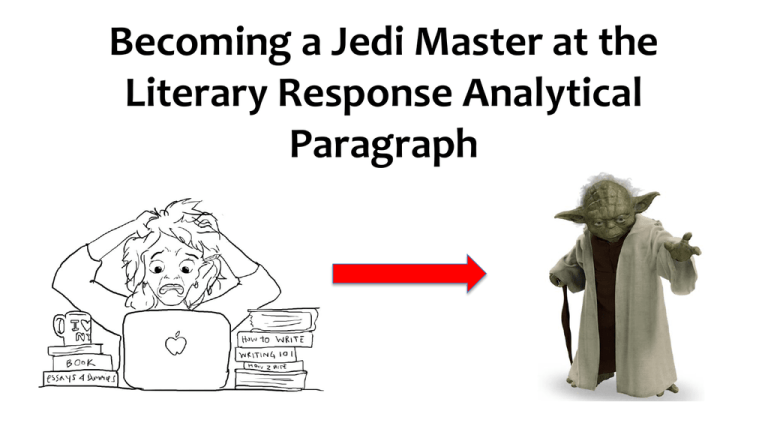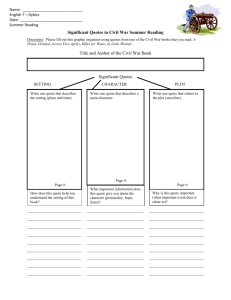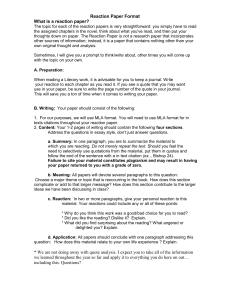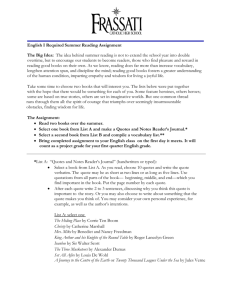Step 4: Quote Analysis/Commentary
advertisement

Becoming a Jedi Master at the Literary Response Analytical Paragraph What are the Essential Elements? • A topic sentence that expresses a clear argument, claim, or interpretation. • It should answer the question/prompt (if there is one). • Supporting ideas or sentences that help explain, clarify, or elaborate upon the topic sentence. • Specific examples in the form of textual evidence that is seamlessly integrated into your own original commentary. • Sharp and insightful commentary/analysis. • Logical flow and organization – Transitions – Strong word choice – Varied sentence structure m p t / Q u e s What is the message/theme of “The Pedestrian” by Ray Bradbury? Step 1: Topic Sentences • SHOULD: – make an arguable claim, assertion (often an inference or interpretation—the point you’re trying to prove). – focused, specific, clear, and not obvious. – Provoke the following response in the reader: “Oh really, now? Let’s see you prove it!” • SHOULD NOT: – describe the plot. – State a fact that you can see for yourself in the text. Step 1: Topic Sentence Examples • Thumbs Up or Thumbs Down? In the story “Gaston,” author William Saroyan writes about a girl and her father. The story of “Cinderella” reveals that one cannot depend on one’s family. In the short story “Gaston,” William Saroyan illustrates the idea that people are easily swayed by the influences around them. In the short story, “The Pedestrian,” the character of Leonard Mead is out on a night time stroll when he is arrested by the police. In the politically correct version of “Little Red Riding Hood,” girls are depicted as strong-minded and independent, suggesting that the stereotypes of girls as weak and dependent are wrong. Step 1: My Topic Sentence • Ex: In “The Pedestrian,” author Ray Bradbury expresses the idea that society has lost the valuable ability for thought and reflection. • Note: See how it is stated or framed as an interpretation in terms of what the author is trying to do (“Ray Bradbury expresses”). • Helpful sentence stems you could use: – The author suggests… implies… highlights… posits… argues… portrays… describes… expresses… asserts… Step 2: Add Supporting Details • The reader may not have read your story, or may not understand your point as well as you do…. Which is why you may need to add a few more sentences to elaborate on your main idea or to provide some background information that’s crucial to understanding the rest of your paragraph. • Ex: In “The Pedestrian,” author Ray Bradbury expresses the idea that society has lost the valuable ability for thought and reflection. This idea is clearly implied by the story, which paints a portrait of a future society that is enslaved to television to such an extent that sitting in front of this machine is all that anyone ever does. Nobody engages in conversation, reads books, or even goes outside for a walk. Nobody, that is, except for Leonard Mead, which is unfortunate for him because by the story’s end, he is taken into police custody for the “crime” of being a pedestrian. Step 3: Quotes – Rules of Thumb • Just 2-3 quotes per paragraph. • Be selective! Don’t choose quotes that say something you could say just as easily. Choose quotes that: 1) Clearly and irrefutably make your point in a sophisticated way. 2) Contains enough “meat” for analysis/discussion. 3) Are not too obvious; they should be noteworthy/memorable. • Don’t begin or end a paragraph with a quote. Step 3: Quotes – Rules of Thumb • Do not use a quote in which two different characters are talking one right after the other; it’s confusing. • Don’t follow one quote with another quote. • As best as you can, use a short section of your quote and weave it into your own sentences. Ideally, your quote is only a phrase or phrases taken out of a longer sentence, so that it’s easier to integrate. Step 3: Selecting/Finding Quotes (aka Textual Evidence) – “The tombs, ill-lit by television light, where the people sat like the dead, the gray or multi-colored lights touching their expressionless faces but never really touching them” (386). – “During the day it was a thunderous surge of cars, the gas stations open, a great insect rustling and ceaseless jockeying for position as the scarab beetles… skimmed homeward to the far horizons” (385). – “…these highways…were like streams in a dry season, all stone and bed and moon radiance” (385) Step 4: Quote Analysis/Commentary • Your quote analysis should come AFTER the quote. • It’s the most important part of your paragraph; it is your opportunity to insightfully convince the reader that your point of view is the right one. • Quote analysis should always answer the following questions: Why is this quote important or significant? What significant features (close reading) are present in the quote and how do they function to support my claim(s)? So what? • Ask yourself these questions every single time you are to write a quote analysis and make sure that your analysis answers the question thoroughly. • Do not re-state what’s already been stated in your quote. Strive for depth! Step 4: Quote Analysis/Commentary • Things You Could Do: – Make connections between the quote and other similar moments in the story; paraphrase them and explain how they emphasize or highlight similar ideas. – Explain how an idea or message might change if the scene had been written differently or the idea in the quote you used had been excluded. – Perform a close reading—look at specific words (diction) or other literary devices (imagery, irony, metaphors, similes, etc.) that the quote contains and explain how they help highlight/support your interpretation. Step 4: Quote Analysis/Commentary • When you are explaining literature to a reader, use language that focuses on something concrete that the writer/author is doing. • Example: – Weak: “Little Red Riding Hood” shows that females can be tough as males. The grandmother, for example, is physically strong, has a tough demeanor… – Better: The author sends the message that females are just as tough as males. He highlights this point by depicting Red’s grandmother as someone with great physical strength. He also portrays Red to be fearless… Step 4: Quote Analysis/Commentary • Take time to walk the reader step-by-step through your logic/reasoning. • Example: – Weak: The only house in the city that is full of light is Leonard Mead’s house. This shows that his house symbolizes knowledge and life. – Better: Leonard Mead’s house is lit up, the only beacon of light in Bradbury’s future society. Bradbury makes this apparent to the reader by emphasizing the tomb-like darkness of the other houses. This contrast between light and dark is introduced to highlight the differences between Mead and everybody else. While his society lives in the “darkness” of their ignorance, Mead—a thinker—lives in a house full of light, which is often used to represent knowledge and enlightenment… Step 4: Quote Analysis/Commentary – “The tombs, ill-lit by television light, where the people sat like the dead, the gray or multicolored lights touching their expressionless faces but never really touching them” (386). • For Bradbury, the houses of the people in this future society are not houses, but “tombs,” as if to suggest that the people are, if not literally “dead,” then at least dead on the inside. Their faces are even “gray” and “expressionless,” without energy, without life. – “During the day it was a thunderous surge of cars, the gas stations open, a great insect rustling and ceaseless jockeying for position as the scarab beetles… skimmed homeward to the far horizons” (385). • Bradbury depicts life as hurried, with cars and daily travels compared to that of insects, which makes the people seem less human, at least as compared to his protagonist, Mr. Leonard Mead. – “…these highways…were like streams in a dry season, all stone and bed and moon radiance” (385) • The simile here also emphasizes Bradbury’s belief that a society without thought and reflection is practically dead as the city that Mead wanders through is like a riverbed bereft of water and life, empty and barren. The only thing missing now is a… • Concluding sentence – Relates back to the topic sentence – Brings paragraph to a close. – Extends the importance of the idea(s) presented in the topic sentence. – Answers the question “so what?” • Why should readers care about your paragraph? Step 5: Adding a concluding sentence • In short, a society that gives up writers and long walks in favor of empty images on a television screen also gives up everything that makes life worth living; such a society may as well give up life itself. Rough draft of our paragraph In “The Pedestrian,” author Ray Bradbury expresses the idea that society has lost the valuable ability for thought and reflection. This idea is clearly implied by the story, which paints a portrait of a future society that is enslaved to television to such an extent that sitting in front of this machine is all that anyone ever does. Nobody engages in conversation, reads books, or even goes outside for a walk. Nobody, that is, except for Leonard Mead, which is unfortunate for him because by the story’s end, he is taken into police custody for the “crime” of being a pedestrian. “The tombs, ill-lit by television light, where the people sat like the dead, the gray or multi-colored lights touching their expressionless faces but never really touching them” (386). For Bradbury, the houses of the people in this future society are not houses, but “tombs,” as if to suggest that the people are, if not literally “dead,” then at least dead on the inside. Their faces are even “gray” and “expressionless,” without energy, without life. “During the day it was a thunderous surge of cars, the gas stations open, a great insect rustling and ceaseless jockeying for position as the scarab beetles… skimmed homeward to the far horizons” (385). Bradbury depicts life as hurried, with cars and daily travels compared to that of insects, which makes the people seem less human, at least as compared to his protagonist, Mr. Leonard Mead. “…these highways…were like streams in a dry season, all stone and bed and moon radiance.” The simile here also emphasizes Bradbury’s belief that a society without thought and reflection is practically dead as the city that Mead wanders through is like a riverbed bereft of water and life, empty and barren. In short, a society that gives up writers and long walks in favor of empty images on a television screen also gives up everything that makes life worth living; such a society may as well give up life itself. Remaining Problems: 1) Dropped Quotes 2) No transitions How can we make it flow better? • Add transitions – Shows reader relationship between one idea and the next. – Makes your writing easier to understand. • Integrate quotes by introducing the quote with signal phrases – So the reader knows where/when you got your evidence – So you don’t commit the literary crime of “dropping quotes,” which make sentences sound ungrammatical and awkward. Integrate Your Quotes! • “Dropped” or “floating” quotes are quotes that appear suddenly in your paragraph without proper introduction or hasn’t been integrated with your own words, creating an awkward, choppy, or “interrupted” effect to the flow of your writing • Examples: – William Saroyan foreshadows the eventual break up of the young girl’s relationship with her father with the fate of Gaston. “And we’ll have to squash it?” (199). – As the story continues, readers are informed that the father is a little eccentric through the man’s physical appearance. “the biggest mustache she had ever seen…he wore a blue-and-white striped jersey instead of a shirt and tie…he wore blue slacks, but no shoes and socks” (193). How to Integrate Your Quotes • A well-integrated quote is a lot like a hamburger: The “top bun” is a sentence of your own thoughts/ideas along with a brief summary which helps explain where in the story that you got the quote. You should always keep in mind that your audience is always someone who is reasonably intelligent but who may not have read the story you are writing about. Consequently, you will want to provide just enough information so that the reader understands what is going on. The “meat” is the quote (using signal phrases and transitions to connect it to the rest of your writing). The “bottom bun” is your quote analysis/commentary. • Example: William Saroyan foreshadows the eventual break up of the young girl’s relationship with her father with the fate of Gaston. “And we’ll have to squash it?” (199). • Revision: William Saroyan foreshadows the eventual break-up of the young girl’s relationship with her father with his depiction of Gaston’s fate. On the phone with her mother while the man is away, the young girl asks, “And we’ll have to squash it?” (199) • Example: As the story continues, readers are informed that the father is a little eccentric through the man’s physical appearance. “the biggest mustache she had ever seen…he wore a blue-and-white striped jersey instead of a shirt and tie…he wore blue slacks, but no shoes and socks” (193). • Revision: As the story continues, readers are informed that the father is a little eccentric through the man’s physical appearance. Saroyan describes him as having “the biggest mustache [the girl] had ever seen”(193) ,and unlike the businessmen she was apparently used to, her father “wore a blue-and-white striped jersey instead of a shirt and tie…and…he wore blue slacks, but no shoes and socks” (193). Citing Quotes • Rule #1: Quotes must be cited with page #s placed inside parentheses after the quotations. Punctuation for the sentence goes AFTER the right parenthesis. • Rule #2: If the quote is the first one to appear in your essay, you must also include the author’s last name. Every quote afterwards only requires a page #. – Example using Barbara Kingsolver’s The Bean Trees: – In the novel The Bean Trees, the character Lou Ann Ruiz ponders a possible split with her husband Angel, but does not “particularly do anything about it” (Kingsolver, 24). Modifying Quotes • Use brackets if you are changing a word in the quote; you may need to do this if you want to keep the sentence grammatically consistent. Do NOT overuse! • Use an ellipsis (…) to indicate that you are omitting words from direct quotes. Sometimes you only need part of a quotation to make a point. – Example using Barbara Kingsolver’s The Bean Trees: – Original Quote: “all I was seeing behind those shut eyes was Newt Hardbine’s daddy flying up into the air, in slow motion, like a fish flinging sideways out of the water. And Newt laid out like a hooked bass” (11). – While learning how to change the tires on her bug, Taylor remarks that her mother could not know that “all [she] was seeing behind those shut eyes was Newt Hardbine’s daddy…And Newt laid out like a hooked bass” (11). Final draft of our paragraph In “The Pedestrian,” author Ray Bradbury expresses the idea that society has lost the valuable ability for thought and reflection. This idea is clearly implied by the story, which paints a portrait of a future society that is enslaved to television to such an extent that sitting in front of this machine is all that anyone ever does. Nobody engages in conversation, reads books, or even goes outside for a walk. Nobody, that is, except for Leonard Mead, which is unfortunate for him because by the story’s end, he is taken into police custody for the “crime” of being a pedestrian. This message is highlighted by Bradbury when he describes the setting. For example, when Leonard Mead takes his usual evening stroll through town, Bradbury describes the home as “tombs, ill-lit by television light, where the people sat like the dead” (386). For Bradbury, the houses of the people in this future society are not houses, but “tombs,” as if to suggest that the people are, if not literally “dead,” then at least metaphorically dead. Their faces are even characterized as “gray” and “expressionless,” without energy, and therefore without life. As Mead continues along his walk, he notices the empty highways and remembers that during the day, they are filled with “a thunderous surge of cars… a great insect rustling and ceaseless jockeying for position as the scarab beetles… skimmed homeward to the far horizons” (385). In this image-laden passage, Bradbury depicts life as hurried, the lives of people in this society akin to the lives of insects. This imagery emphasizes society’s loss of humanity. And as busy as the highways are during the day, Mead observes that at night, they “were like streams in a dry season, all stone and bed and moon radiance” (385). The simile here also emphasizes Bradbury’s belief that a society without thought and reflection is as practically dead as a riverbed bereft of water and life, empty and barren. In short, a society that gives up writers and long walks in favor of empty images on a television screen also gives up everything that makes life worth living; such a society may as well give up on life itself. Final Tips • Write in 3rd person, formal academic voice. – No contractions! – Ban phrases like “I think,” “In my opinion,” or “I believe.” • Literary present tense! – The stuff/events of literature always occur in the present moment. • Ban stiff, awkward, and trite phrases from your writing toolbox! – “In this quote…” (Blah!) – “This quote shows that…” (Yuck!) – “This shows that…” (Ew!) Your Assignment (25 Essay Category Points) • Write a literary response analytical paragraph about ONE of the stories we’ve read/studied so far answering the following question: – What message does the author of your story want readers to understand or take away? How is this theme developed? • Typed, double-spaced, MLA Format (11-12 point font, 1” margins, proper heading, title), and under 450 words. – Your paragraph will be docked two points if it goes over the word limit. • Due: turnitin.com by 8AM on Monday Morning (9/9).




